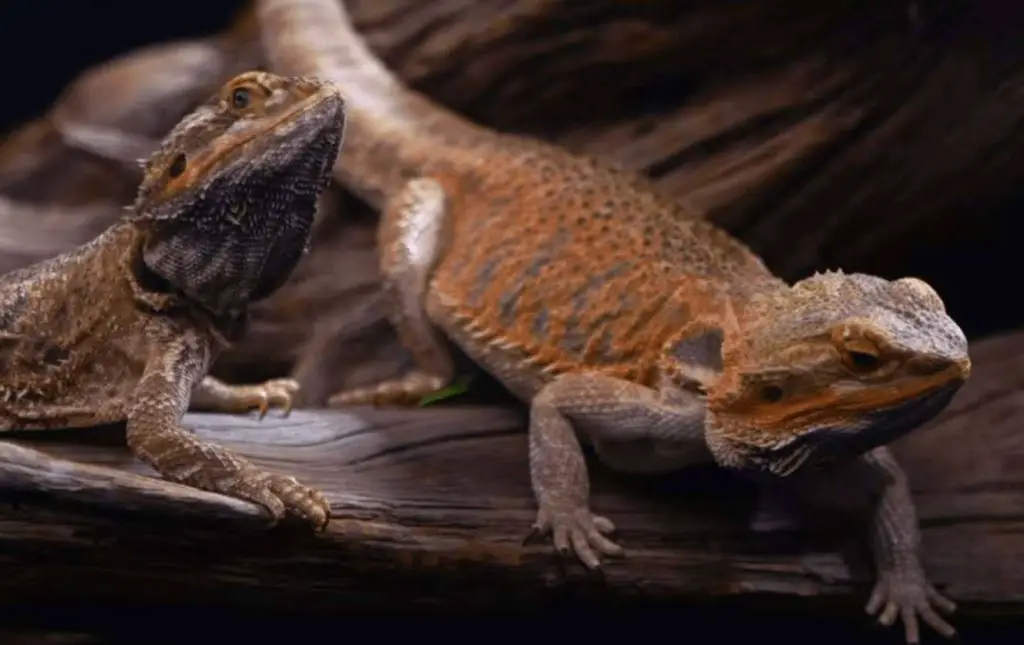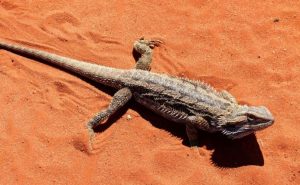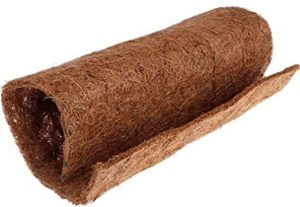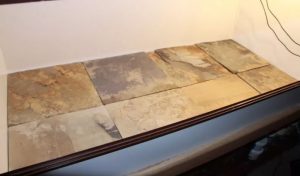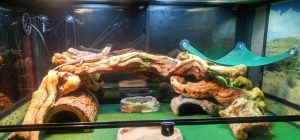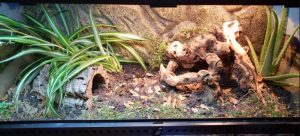The substrate for bearded dragons is one of the most important factors when it comes to setting up your bearded dragon enclosure. It does not only make them feel comfortable but also impacts their health.
Therefore choosing a good and suitable substrate will affect the overall health condition and experience of your dragons in their terrarium.
So now you may wonder what kind of substrate for your bearded dragons?
Let’s find out with us!
We’ve listed out some popular available options that you can consider and opt for the one that your pet deserves!
Related:
- Can Bearded Dragons Live Together?
- Bearded Dragon Shedding
- Mbd In Beardies
- Beardie Ask Questions
- How Big Can a Beardie Get?
- 30+ Beardie Body Language
- How Do Beardies Sleep?
- Beardie Brumation Or Dead – How To Differentiate?
- How To Pick Up a Beardie?
List Of Substrate for Bearded Dragon
1. Newspaper

Old newspaper is probably the most economical substrate for your bearded dragon tank.
Most newspapers are disposable easily when soaking in liquids, which is ideal to prevent the mess from spreading around your beardie tank.
Also, the paper is pretty sturdy, so you don’t have to worry that your pet’s feet will get slipped when he becomes active.
Newspapers can be found at some pet stores, which have washed and shredded newspapers.
This makes it not only a good substrate for bearded dragons that like digging but also a sure-fire way to minimize impaction.
If you’ve got the freshly printed newspapers, remember to leave it out at room temperature for several weeks before putting them in the tank.
By this, you can make sure that the printing features have dried completely.
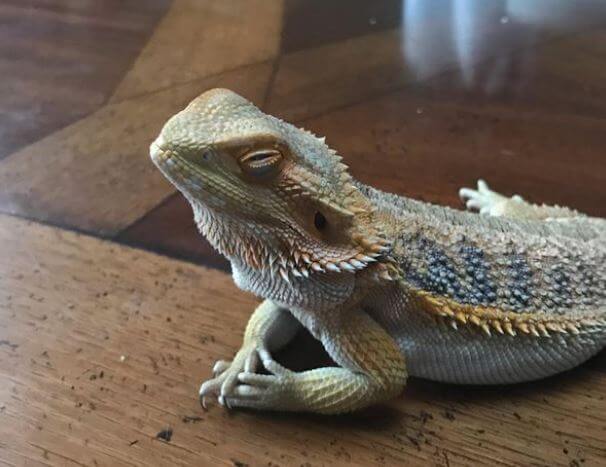
Besides those amazing features, there are still some downsides with this type of bearded dragon substrate.
First, newspapers are not as pleasing as sand.
As we’re used to seeing the bearded dragons digging and playing on the sand area, the newspapers may make the enclosure less playful and attractive.
Also, the paper can retain humidity, which is not preferable and safe for your dragons.
2. Paper Towel
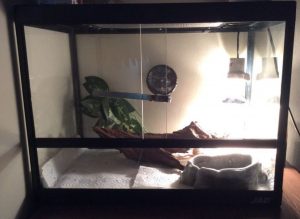
Using a paper towel is another available disposable option to cover the ground of the enclosure.
However, they are much neater than newspapers.
The feature that makes it so popular is its impressive absorbing power, which reduces the humidity in the bearded dragon habitat.
This helps to avoid the chance of developing hazardous diseases that harm your dragon lizard’s health.
Along with the newspaper, using a paper towel for the enclosure is also a wonderful choice for those who have a tight budget.
The most important thing you should take into account when using this substrate for bearded dragon is checking and replacing the paper regularly to avoid germs left in the tank.
3. Sand – Not Recommended Substrate for Bearded Dragons
Sand sound like the most optimal substrate for your bearded dragon as it’s natural and decorative.
Don’t let that common thought fool you! It’s the most debated option dues to the potential of causing a risk to your dragon lizards.
Sand has a negative impaction on the dragon’s health, especially its ingestion.
As sand can’t be digested, it would be a real hazard once the dragon eats it accidentally.
When it comes to the baby bearded dragons who ingest particles when they’re eating and is the most dangerous source for their health which can even kill them.
Other than the impact on ingestion, sand also harms the eyes and nose, resulting in serious infections.
Additionally, when you scoop the poop of your dragon is out of the tank, you may leave some fecal matter which could be in juices, flecks, or even both.
If you still want to use sand for your dragon’s habitat despite all the possible issues, you will need to keep an eye on it every day. Don’t forget to take out the solid parts and replace it about once per month.
Also, when you feed your dragon lizards, put food in a smooth place such as plates or plastic led to reducing the risk of the dragon swallowing it.
4. Coconut Coir
Another easily available and popular choice is coconut coir.
Although is anti-microbial function is out of this world, it’s not recommended for bearded dragons.
This is because coconut coir has the possibility of causing impaction and retaining moisture, which is not preferable for a desert habitat.
Too much humidity is harmful to the dragon’s respiratory and overall health condition.
5. Wood Shavings
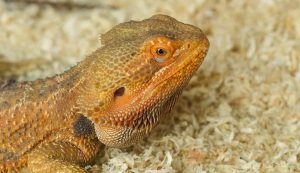
Wood Shavings come with a big NO when it comes to putting in the beardie tank.
This is because they consist of chemicals and toxins, which result in impaction and infectious diseases.
If you think about finding wood shavings that are chemical-free, we’ll let you know it’s impossible.
So to prevent any harm to the dragon lizard’s health and even your own, you should always avoid using this as a substrate for the enclosure.
Related:
- Why Is My Beardie Bobbing His Head?
- Why Is My Beardie Breathing Heavy?
- Reasons Why Your Beardie Turned White And Died
6. Vinyl Tiles
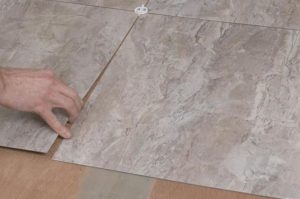
Vinyl Tiles have become more popular among bearded dragon owners these days.
There are several reasons for this popularity.
The tiles are cheap and available in a wide range of colors. Also, they are easy to cut. So if you want to adjust the size to fit your tank, you can cut it easily.
The vinyl tiles are also non-porous.
That means swiping water and poop off the tile are simple and can be done within a few seconds.
Unfortunately, there are still some disadvantages that come with this bearded dragon substrate.
The texture is very smooth, which makes less grip for your bearded dragon who is into digging.
Another problem is related to the effect of plastic, which can cause some potential issues especially when it’s heated inside the terrarium.
Though this concern has not been confirmed yet, as far as we know about human housing, we would mention this caution so you can pay more attention when using this substrate for bearded dragons.
7. Ceramic Tiles – Sustainable Substrate for Bearded Dragons
Other than Vinyl Tiles, Ceramic Tiles have been known to be a trend as a substrate of the bearded dragon enclosure.
These tiles are usually used in your bathroom or kitchen.
Same as vinyl tiles, they have a variety of colors and textures, including those similar to sand and stone.
The ceramic tiles are affordable and easy to cut as well.
At the same time, you can clean this substrate easily, giving it a nice and decorative look while eliminating the impaction problems.
The only feature that you should focus on is its position.
Avoid putting them under the basking spot if the enclosure is already heated properly.
8. Slate
Slate is properly the most attractive and natural-looking in this list of substrate for bearded dragon cage.
Most importantly, it provides high qualities, making the terrarium an ideal place for your dragon.
The slate does not only offer a good grip for the dragon lizard’s movement but it also radiates heat and keeps the warm airflow.
Besides those great features, the slate still has some downsides.
Compared to the vinyl tiles or ceramic tiles, it’s a real challenge when it comes to cutting the slate.
Additionally, the slate is porous which could absorb feces as well as impurities easier than other types of bearded dragon substrate.
9. Reptiles Carpet
Next on this list is the reptile carpets or cage liners.
As they are designed to simulate grass or sand, this is pretty preferable for bearded dragon enclosure.
However, this bearded dragon substrate can’t last for long.
This is because the dragon lizard tent to defecate a lot, the carpet may get soiled easily and quickly.
If you plan to buy a reptile carpet, you should ensure the one you get is friendly with a bearded dragon.
It means there are no fiber loops that stick out so that your dragons won’t get hurt if they accidentally stuck their fingers there.
10. Bioactive Substrate – Best Substrate For Bearded Dragons
The last substrate for a bearded dragon to be mentioned in this list is the bioactive substrate.
This option is ideal for those who are willing to accept the potential risk of loose substrates and interested in creating a natural-looking habitat for their dragons.
The bioactive substrate comes with a lot of benefits.
The feature that impresses us most is its control over moisture and air.
Thanks to this function, it helps to create an enclosure that is beneficial for the growth of microflora and fauna, supporting the biological decomposition of the vivarium waste. That’s what makes it bioactive.
Also, this type of substrate is helpful for plant growth.
As long as the layer is thick as required, it will hold a certain shape.
That means your dragon could create some burrows instead of digging without any results.
Unfortunately, bioactive substrates are still able to develop compaction.
We would recommend every owner to do a test based on the bearded dragon’s characteristic, health condition, and eating habits.
a. Humidity
Dragons that inherently live in arid to semi-arid areas and other habitats in the wild can undergo the fluctuations in RH from 20% to 80% with an average of 40-60% RH.
This is to say that these dragons are pretty strong and can endure a wide range of humidity quite well.
A combination of sterile enclosures with stagnant air may lead to fungal and bacterial blooms.
On the other hand, a completely barren environment is more likely to bring some issues relating to the lungs and the immune system of your dragon.
However, you can stop these negative respiratory issues by keeping the tank at a proper temperature and providing it with well ventilated utilizing cross vents.
b. Drainage Layer
Many pet owners consider whether to use a drainage layer or not.
In my opinion, a small drainage layer may be useful as in the case of overwatering, you would need to likely change your ENTIRE setup as the soil gets humid and anaerobic very quickly.
Therefore, It’s very good for you to use this safety net and it could only take .5-1 inch in your setup.
If you do not want to add weight to your build, you should choose to use plastic lighting diffuser or egg crate.
You can hold up the half–inch–square plastic grid by zipping tying it to itself, or a small amount of PVC tubing works fine.
Adding leaf litter on the top will be helpful in some ways as it not only provides a food source, a shelter for the cleaners but also serves to trap humidity under the soil for the cleaners mostly.
Also, the chance of your dragon consuming the bearded dragon substrate will be reduced.
You can use most fine fruit tree leaves are fine to use.
I personally do not use it as I can deal with three purposes without them.
Related:
- Can Beardies Eat Rosemary?
- Can Beardies Eat Brussel Sprouts?
- Do Beardies Eat Peas?
- Can Beardies Eat Squash?
- Can Beardies or Dogs Eat Pears?
c. The Tank Setup
It is common for the minimum space size for a single bearded dragon to be a 36x18x18 inch enclosure, which allows you to do a bioactive enclosure.
However, regarding the smaller tanks, they will have less substrate, and thus, less clean housing, which means having enough substrate is very important.
Otherwise, the cleaners won’t be able to keep up with the food amount.
In my opinion, a 4x2x2 feet enclosure will be perfect.
d. Cleaners In The World
Cleaners that make the bearded dragon substrate actually bioactive are micro and macro-organisms.
The feces, detritus, decaying, and decayed materials in the enclosure are their main food sources and help to create a biological cycle in your enclosure. Some examples of macro-organisms would be a few of the following.
- Superworm beetles and their larvae
- Mealworm beetles and their larvae
- Lesser Mealworm beetle and their larvae
- Dermestid beetle and their larvae
- Crickets
- Various species of roaches like dubia, hissers, etc.
- Compost worms
- Fly larvae or maggots
- Earthworms. Red worms or African nightcrawlers will do better than the others.
- Isopods
- Springtails
e. Live Plants
As we can see, plants can serve various purposes.
They are not only used to dress up the terrarium with their sense of nature and beauty but also play an important role in the bioactive tank.
At the end of the cycle of the cleaners consuming the feces, the plants can then utilize the feces of the cleaners in order to use as a nutrient source like an organic fertilizer so you don’t need external chemicals and fertilizers.
Read more:
To Wrap Up
There are many types of substrates on the market that you could choose for your pet habitat. Some offer great features and benefits while others are not recommended at all.
To be clear about what kind of substrate for bearded dragons, the most vital thing you should take into account is its quality and impact on the overall health condition of your dragon lizard, making it a safe and comfortable terrarium.
Key points for selecting the best substrate for a bearded dragon:
Choosing the right substrate for your bearded dragon’s enclosure is crucial for their health and well-being. Substrate serves various purposes, including providing a comfortable surface for your pet, aiding in maintaining proper humidity levels, and facilitating waste cleanup. Here are the key considerations and options for bearded dragon substrate, presented in bullet points for easy reference:
1. Safety and Ingestion Risk:
- Ingestion Concerns: Bearded dragons are known to be curious feeders and may accidentally ingest substrate while hunting or eating. Avoid substrates that pose a significant ingestion risk.
2. Common Substrate Options:
- Reptile Carpet: A popular choice, reptile carpets, also known as indoor/outdoor carpet or felt, are easy to clean and provide a comfortable surface for bearded dragons. However, they may not help with maintaining humidity levels.
- Ceramic Tile: Ceramic or slate tiles are excellent options. They’re easy to clean, won’t be ingested by your pet, and they help maintain proper nail health through natural wear.
- Paper Towels/Newspaper: While not aesthetically pleasing, these substrates are safe, easy to replace, and cost-effective.
- Bioactive Substrate: Bioactive setups utilize live plants, organic materials, and microfauna (like isopods and springtails) to create a self-sustaining ecosystem. They can be beneficial but require more expertise.
- Play Sand and Other Loose Substrates: Loose substrates like play sand, calcium-based sand, and walnut shell can pose ingestion risks if not monitored carefully. They are not recommended for young or inexperienced bearded dragon keepers.
3. Avoid Calci-Sand:
- Calci-Sand Risks: Calci-sand, a calcium-based sand, was once marketed as safe for bearded dragons. However, it can still lead to impaction if ingested and is best avoided.
4. Substrate Depth:
- Shallow Substrate: Keep the substrate depth shallow (around 1/2 inch to 1 inch) to reduce the risk of impaction.
5. Hygiene and Cleaning:
- Regular Maintenance: Regardless of the substrate you choose, it’s important to maintain a clean and hygienic environment. Spot clean waste daily and replace or clean the substrate as needed.
6. Monitor for Impaction:
- Vigilance: Keep an eye on your bearded dragon’s behavior and health. Signs of impaction include lethargy, loss of appetite, and difficulty defecating.
7. Bioactive Setups:
- Complexity: Bioactive substrates can create a more enriching and natural environment for your bearded dragon. However, they require careful planning and ongoing maintenance.
8. Consider Your Bearded Dragon’s Age:
- Hatchlings and Juveniles: Young bearded dragons are more prone to ingesting substrate. Safer options like reptile carpet or paper towels are recommended for this age group.
- Adults: Adult bearded dragons may handle loose substrates better, but it’s crucial to monitor their behavior closely.
Choosing the right substrate for your bearded dragon involves considering the safety, maintenance, and comfort of your pet. Always keep a close eye on your dragon’s behavior and consult a reptile-savvy veterinarian if you notice any health concerns. Substrate selection is a critical aspect of creating a healthy and comfortable habitat for your beloved bearded dragon.
Further Reading:
- Carolina Custom Cages Terrarium Review | What Are Pros And Cons?
- 8 Best Basking Rock For Beardie: What Is The Best Choice?
- 10 Best Thermometer For Beardie: How To Choose The Best One?
- 5 Best Beardie Lighting Setup for Beardie Lovers
- 9 Best Heat Lamp For Beardie: Natural Habitat Provided

